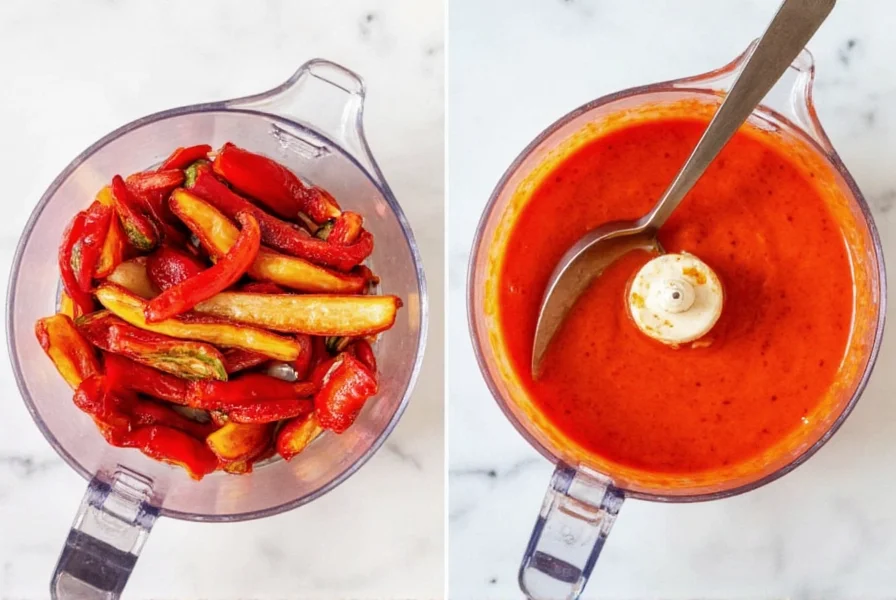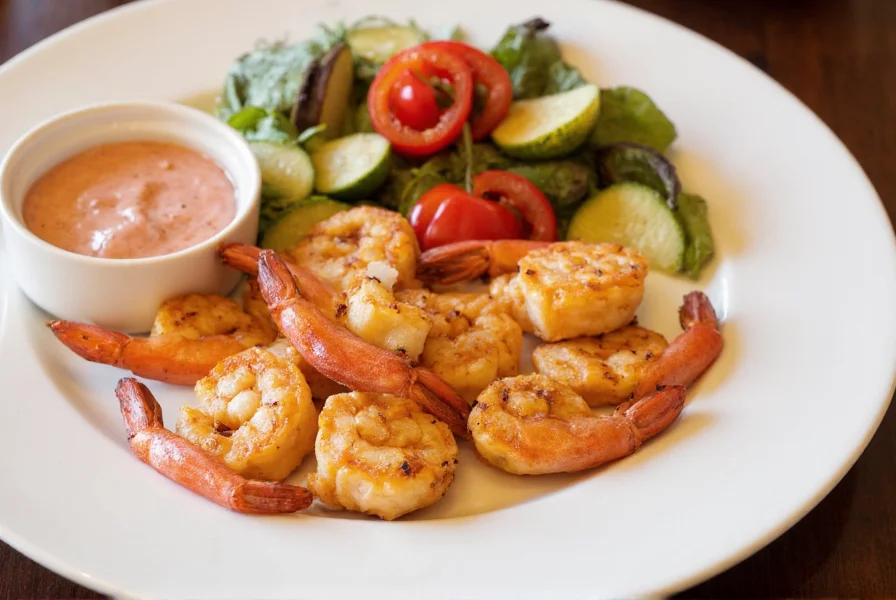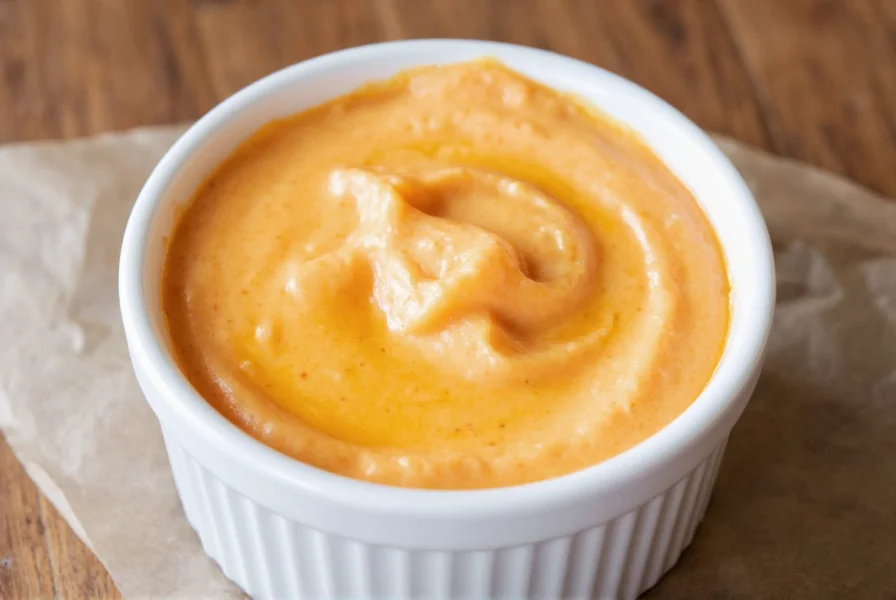Understanding Red Pepper Aioli's Culinary Foundation
At its core, red pepper aioli transforms the classic Provençal garlic mayonnaise by incorporating roasted red peppers. The magic happens when sweet, smoky roasted peppers meet the pungent garlic and rich emulsion of traditional aioli. Unlike regular mayonnaise, authentic aioli relies on the emulsifying properties of raw egg yolks and careful oil incorporation, creating a sauce with superior texture and depth.
Professional chefs prefer using freshly roasted peppers rather than jarred varieties for homemade red pepper aioli recipe applications. The roasting process caramelizes the peppers' natural sugars, developing complex flavor notes that jarred alternatives often lack. When properly prepared, this sauce should have a smooth, velvety texture with visible flecks of red pepper providing visual appeal.
Essential Ingredients Breakdown
| Ingredient | Function | Professional Recommendation |
|---|---|---|
| Roasted red peppers | Primary flavor and color | Use 1 large pepper per cup of finished aioli |
| Fresh garlic | Traditional base flavor | 1-2 cloves max to avoid overpowering |
| Egg yolks | Emulsifier and richness | Use pasteurized for safety |
| Extra virgin olive oil | Body and authentic flavor | Mild variety to avoid bitterness |
| Lemon juice | Acidity and balance | Freshly squeezed only |
Step-by-Step Preparation Guide
Creating perfect red pepper aioli requires attention to technique. Start by thoroughly roasting and peeling your peppers—this step cannot be rushed for the best roasted red pepper aioli ingredients profile. While traditional aioli is made by hand-whisking, modern cooks often use food processors for consistent results when making red pepper aioli from scratch.
- Roast 1 large red bell pepper over open flame or under broiler until charred
- Place in sealed bag for 10 minutes, then peel and seed
- Combine 1 egg yolk, 1 small garlic clove, and 1 teaspoon lemon juice in processor
- With motor running, slowly drizzle in ¾ cup olive oil until emulsified
- Add roasted pepper and pulse until smooth but still slightly textured
- Season with sea salt and additional lemon to taste
- Chill for 2 hours before serving to allow flavors to meld

Perfect Pairings for Red Pepper Aioli
Understanding what to serve with red pepper aioli transforms ordinary meals into culinary experiences. This sauce shines brightest with foods that benefit from its sweet-spicy contrast:
- Seafood: Grilled shrimp, fish tacos, and crab cakes
- Vegetables: Roasted asparagus, artichoke hearts, and zucchini sticks
- Appetizers: Crostini, vegetable crudités, and stuffed mushrooms
- Sandwiches: Turkey clubs, veggie wraps, and grilled cheese
- Proteins: Grilled chicken, pork tenderloin, and lamb chops
For the best bread for red pepper aioli dipping, choose crusty artisan breads that provide textural contrast without overwhelming the sauce's delicate flavor. Baguettes, ciabatta, and sourdough slices work particularly well when lightly toasted.
Storage and Shelf Life Considerations
Homemade red pepper aioli maintains peak quality for 3-4 days when stored properly in an airtight container in the refrigerator. The egg content means you should never leave it at room temperature for more than two hours. Professional chefs recommend labeling containers with preparation dates to ensure freshness.
Unlike commercial versions, authentic red pepper aioli vs regular aioli made from scratch lacks preservatives, so its vibrant color may fade slightly after day two. Stirring gently before serving restores much of the original appearance. Never freeze aioli, as the emulsion will break and texture will become watery upon thawing.
Common Mistakes to Avoid
Many home cooks encounter issues when attempting red pepper aioli for the first time. The most frequent problems include:
- Broken emulsion: Caused by adding oil too quickly—always drizzle slowly while processor runs
- Overpowering garlic: Use no more than 1-2 small cloves for balanced flavor
- Watery texture: Results from insufficient roasting or excess pepper liquid
- Bitter notes: Occurs when using strong olive oil varieties
For those seeking spicy red pepper aioli variations, consider adding a pinch of cayenne or smoked paprika rather than hot sauce, which can introduce unwanted vinegar notes. The roasted peppers should provide the primary flavor foundation.

Frequently Asked Questions
Can I make red pepper aioli without eggs?
Yes, you can create an egg-free version using Greek yogurt or silken tofu as the base. While not traditional aioli (which requires egg), this variation still delivers excellent flavor. Use ½ cup Greek yogurt plus ¼ cup olive oil, blending with roasted peppers and garlic for a healthier alternative that maintains creaminess.
How can I adjust the spiciness level of red pepper aioli?
Control spiciness by selecting different pepper varieties. For mild flavor, use standard red bell peppers. For noticeable heat, incorporate ¼ teaspoon of chipotle powder or replace one bell pepper with a roasted poblano. Avoid raw hot peppers as their sharp heat conflicts with aioli's creamy profile.
Why does my homemade red pepper aioli separate?
Separation occurs when the emulsion breaks, usually from adding oil too quickly or using ingredients at different temperatures. To fix it, start a new emulsion with one teaspoon of water or lemon juice, then slowly incorporate the broken mixture. Prevent separation by ensuring all ingredients are at room temperature before beginning.
What's the difference between red pepper aioli and remoulade?
While both are creamy sauces, red pepper aioli features roasted peppers as the primary flavor with garlic prominence, while remoulade typically includes capers, cornichons, and herbs like tarragon. Aioli has a smoother texture and sweeter profile, whereas remoulade offers more complex, briny notes from its additional ingredients.
Can I use jarred roasted red peppers for red pepper aioli?
Yes, but drain jarred peppers thoroughly and pat dry with paper towels to remove excess liquid. For better flavor, briefly sauté the drained peppers to evaporate remaining moisture and concentrate flavors. Freshly roasted peppers always yield superior results, but quality jarred versions work in a pinch for your red pepper aioli recipe.











 浙公网安备
33010002000092号
浙公网安备
33010002000092号 浙B2-20120091-4
浙B2-20120091-4